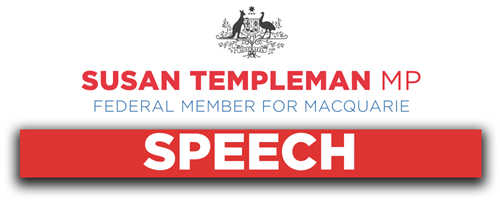
I want to thank the member for Indi, and the member for Moreton before her, for acknowledging my work as Special Envoy for the Arts in the consultation on our National Cultural Policy and, importantly, for their passionate endorsement of the arts sector, which we know is about much more than going and seeing a show; it's about who we are as Australians and the stories that we tell.
The Arts portfolio spans a very wide range of activities and programs that enrich and shape people's lives. I'm very much looking forward to the release of the National Cultural Policy, but I want to talk about the work of one lesser-known area of the Arts portfolio, and this is the area that carries out repatriations of ancestral remains from around the world. This falls under the Arts portfolio. I'm proud to be standing in this place wearing two special pins. One is the symbol of the Australian government's Indigenous repatriation program, and I wear it very proudly, having taken part in a repatriation this month in Leipzig, Germany, from where the ancestral remains of six Aboriginal men and women were returned to the safekeeping of community representatives. I accompanied the representatives of the Gadigal, Awabakal, Warrimay and Mutti Mutti people who had been given the responsibility by their communities to bring their old people home.
Australia cannot truly be at peace with itself as a nation while the journey of reconciliation is incomplete. As the delegation and I travelled to the other side of the world together, they shared with me their hope that we were taking a step closer to reconciliation. There are many injustices that have been perpetrated against Australia's First Nations people that we must acknowledge and strive to put right. In the 19th and 20th centuries, the remains of many First Nations Australians were separated from their country and traded, ultimately ending up in museums around the world. This caused profound and ongoing grief to First Nations people. It should never have happened. These ancestors should never have been taken away from their country. Several community representatives in the delegation told me that repatriation of ancestors is a crucial part of the process of healing, truth-telling and reconciliation. Because of this repatriation, these ancestors can return to country where they belong.
The government has supported the repatriation of ancestors from overseas for more than 30 years, and, yes, it happens through the department of the arts. Since 1990 more than 1,600 ancestors have been returned to Australia. I pay tribute to the state of Saxony, the State Ethnographic Collections of Saxony and the Grassi museum for this repatriation, particularly Leontine Meijer-van Mensch, director; Birgit Scheps-Bretschneider, curator of the Australian and South Pacific collections; and Juliane Heinze, all of whom made it possible for these ancestors to come home.
The German museums are doing nothing wrong right now. They are trying to right a wrong that occurred in the past. I thank them for the respect that they've shown to First Nations community representatives who are there to collect the remains that have ended up in their institutions. The repatriation sets an example that other institutions should look to. Many of the museums who've agreed to repatriations have found that the process has opened anew chapter in their histories. In many instances, it has led to constructive and positive relationships between the museums and Indigenous people in which knowledge can be shared and important new dialogues opened.
I want to acknowledge the representatives who travelled with me as part of the delegation: Rowena Welsh, Kaleana Reyland, David Feeney and Kumarah Kelly, who were joined by Nathan Moran, Jennah Dungay, Lindsay Munro and Jacqueline Gibbs, as well as Worimi man Jamie Tarrant. That brings me to the second special pin, which he asked me to wear in this place. It represents the Worimi Conservation Lands that he cares for around Nelson Bay, and I'm very proud to wear it. Thank you all for including me on your journey and letting me see your strength, your vulnerability, your generosity and your dignity.
I also want to acknowledge the staff of the Department of Infrastructure, Transport, Regional Development, Communications and the Arts for their diligent work in negotiating the repatriation of these ancestors and for the sensitivity they've shown in doing so—director David Doble and assistant director Amanda Morley and the team. Without David's commitment and Amanda's determination we would not have had ancestral remains being returned. They have much work to do, and I look forward to our government supporting


